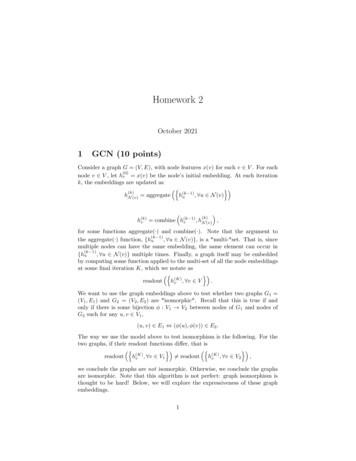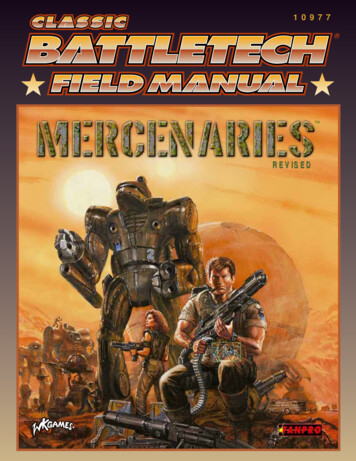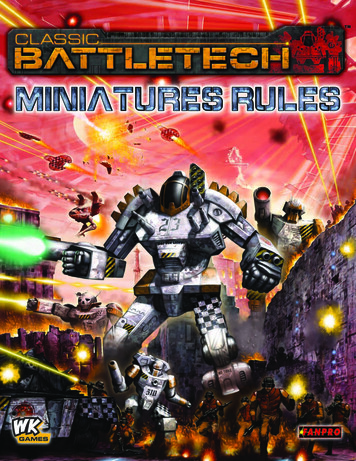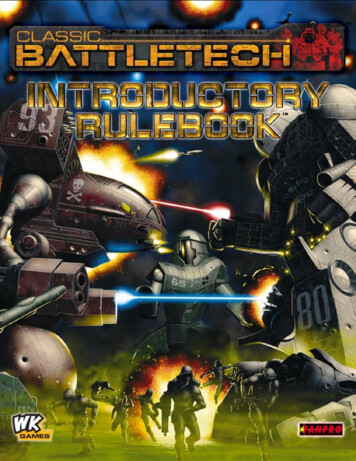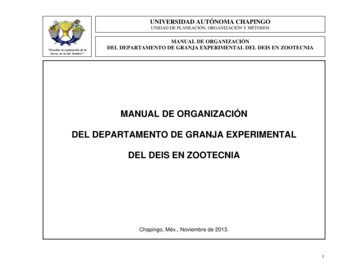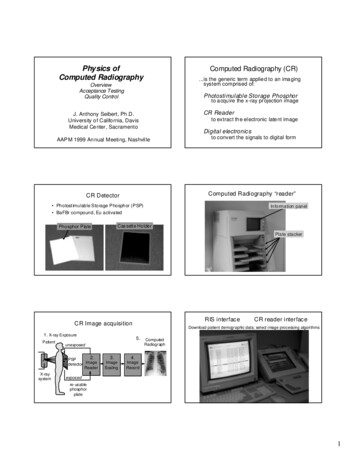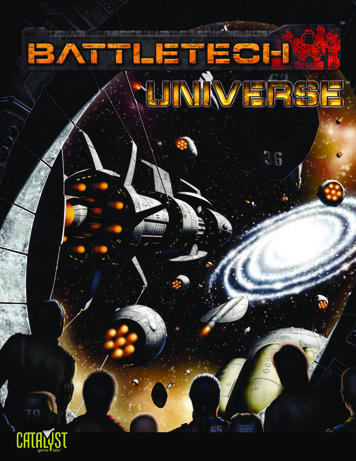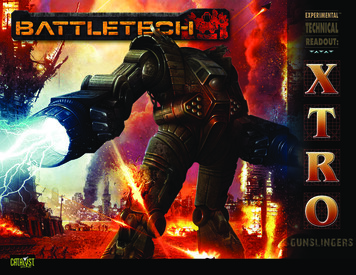
Transcription
INTRODUCTIONTO: Paladin Janella LakewoodFROM: Ghost Knight XXDate: 1 January 3146Open any technical digest printed in the last forty years and you’ll see one recurring theme. Somewhere in the introductory text or the précis descriptionsor combat performance reports you’ll see the phrase “Star League-era technology” used to describe an advanced component or weapon system. The originalStar League was an unprecedented technological developer, with uncounted scientific breakthroughs in all aspects of society, but in the aftermath of theSuccession Wars the only real interest the Great Houses had was in military technology—and even in that specific focus, the Star League did not disappoint.Advanced materials and weaponry were rediscovered shortly before the return of Kerensky’s Clans and rushed into frantic production. Once theinvasion was halted and the Inner Sphere discovered that the Clans had progressed technologically beyond even the high water mark of the Star League theirscientists threw extraordinary efforts into designing and manufacturing evermore advanced and devastating weaponry. Some of these advances were honestbreakthrough of original thought, but the majority was distilled from the raw materials provided by the Star League centuries ago. Technicians and engineerspored through the Helm memory core and any old references they could located, rebuilding long-forgotten prototypes and retesting failed experiments.Much of that research has been gathered here, combined from the fragmentary records of all four remaining Successor States and those archives thatsurvived the Word of Blake’s occupation of Terra. Stefan Amaris the Usurper captured Terra and its collaborationist population intact, and used the knowledgeand manufactories available there to try and create the ultimate weaponry to hold back General Kerensky’s onslaught. Many prototypes were designed, farmore than ever reached initial production, as both sides jockeyed for an edge against the other. We have endeavored to draw a sampling of these systems bothas a tribute to the ingenuity of those engineers and scientists and as a tool to developing newer systems of our own. The Republic of the Sphere representsthe best of the Inner Sphere, but the Clans are still out there. The Capellan Confederation still covets its former worlds. Conflict, although greatly lessened, isstill present, and if the RAF is to protect the Republic worlds it must have the best weaponry available.And so we offer this treatise, a digest of several of the prototypical and unique craft of the Star League, in the hopes that the information may lead to thedevelopment of a new and more powerful tool to safeguard the Republic. None of these vehicles made it beyond prototype stage, although several of them sawactual combat in the last minutes of Amaris’ control of Terra. Several of them had large prototype groups—the long-range recon patrol variant of the Beagle, forinstance, ran to fifty-seven chasses before the SLDF decided to pass on the design. Most of them used equipment that never made it to standard production inthe SLDF, although all the technologies have survived to the present era. In one instance, the Rifleman III, its actual construction was only conjecture before thereclamation of old ruins after the Word of Blake’s defeat. Its wreckage was discovered beneath a collapsed skyscraper in Buenos Aires, and Republic techniciansand archeologists have been studying it and combing the archives for technical data.Advancement in military technology, as with any other technology, has always been trial-and-error. We hope to assuage some of the errors to come, butshowcasing the errors of the past.—Introduction to The Old School: Prototype Weaponry of the First Star League by Doctor Harrison Beech, Geneva Press, 3084.HOW TO USE THIS BOOKThe ’Mechs, combat vehicles, and fighters described in Experimental Technical Readout: Gunslingers provide players with a sampling of the various customdesigns that have existed during the last days of the First Star League. The designs featured in this book reflect limited-run prototypes and “one-offs” that haveyet to reach full factory production—and most likely never will.The rules for using ’Mechs, vehicles and fighters in BattleTech game play can be found in Total Warfare, while the rules for their construction can be foundin TechManual. However, the experimental nature of these designs also draws upon the Experimental-level rules presented in Tactical Operations. Thus, noneof the units featured in this volume are considered tournament legal, and their use in introductory games is discouraged. Furthermore, the extreme rarity ofthese machines is such that none of them should occur in a BattleTech campaign as a chance encounter, but the capture or destruction of any one of theseprototypes could be potential objective for BattleTech scenarios, tracks and role-playing adventures.1
INTRODUCTIONCREDITSFactchecking/Playtesting: Joel Bancroft-Connors, JohannesHeidler, Luke Robertson, Patrick Wynne.Special Thanks: Special thanks for this project series go outto Randall Bills (for conceiving it), Jason Schmetzer (for having thesecond book basically ready to go and being incredibly patient that ittook us over two years to get this one out the door), Brent Evans (forthe art mods), and Ben Rome, Joel Bancroft-Connors, and Paul Sjardijn(for their varying degrees of support).Project DevelopmentHerbert A. Beas IIDevelopment AssistanceRandall N. BillsJason SchmetzerBattleTech Line DeveloperHerbert A. Beas IIAssistant Line DeveloperBen H. RomePrimary WritingJason SchmetzerWriting AssistanceHerbert A. Beas IIProduction StaffCover Design and LayoutRay ArrastiaOriginal IllustrationsChris DaranouvongMatt PlogUnder License From 2014 The Topps Company, Inc. All RightsReserved. Experimental Technical Readout:Gunslingers, Classic BattleTech, BattleTech,BattleMech, ’Mech and the Topps logo areregistered trademarks and/or trademarks ofThe Topps Company, Inc., in the United Statesand/or other countries. Catalyst Game Labs andthe Catalyst Game Labs logo are trademarks ofInMediaRes Productions, LLC.CAT35XT0132STAR LEAGUE ERACLAN INVASION ERASUCCESSION WARS ERAJIHAD ERACIVIL WAR ERADARK AGE ERA
MON-66GX Mongoose GunslingerField Testing Summation: Customized MON-66 ConceptProducer/Site: Diplan ’Mechyards/OzawaSupervising Technician: Georges FordhamProject Start Date: 2 April 2766Non-Production Equipment Analysis:Null-Signature SystemChameleon Light Polarization ShieldOverviewAlthough long prized among front line forces for its role asa scout, the Mongoose was also a popular choice for light ’Mechgraduates of the Star League’s Gunslinger program on Mars. Fast,well-armed, and familiar, the Mongoose remained preeminent untilits near-extinction during the Succession Wars, with few variantsmade to its basic design. When researching the model for possibleupgrades in the 3050s, ComStar discovered the technical specs fora dueling prototype that Diplan ’Mechyards offered to the SLDF’selite Gunslingers.For a duelist the Mongoose was overburdened by its scoutingequipment; the ronin never attacked from ambush, and theirduels nearly always took place in well-regulated areas, with littleopportunity for deceit. In order to make the Mongoose a moredeadly fighter, Diplan stripped out the electronics and increasedthe weaponry. Four medium lasers—two in each arm—providedadequate fields of fire and a very respectable barrage capabilityagainst the other lightweight opponents Mongoose Gunslingerscould expect to face. For added power, a six-tube short-rangemissile battery was installed in the chest, providing an excellent“surprise” against opponents who would not expect a scout ’Mechto have such formidable armament.Increased armor protection helped provide for betterresilience, but the real defensive power lay in what the Diplanengineers replaced the scout electronics with. Including the NullSignature anti-infrared system and the visual-masking ChameleonLight Polarization Shield, the Mongoose Gunslinger would havebeen the only light ’Mech of its day to mimic the capabilities ofthe infamous Exterminator BattleMech. The intended tactic—especially against long-range ’Mechs—was to use this ability to foilenemy sensors long enough for the Mongoose to close in, where itssuperior short-range firepower and maneuverability would makeit possible for the warrior to maintain contact until their opponentwas defeated.A single Mongoose Gunslinger was created as a demonstrator,but the SLDF command never approved the project, citing the’Mech’s expense and concerns that MechWarriors trained onstandard Mongooses would be inclined to use these machines“inappropriately.”3Type: Mongoose GunslingerTechnology Base: Inner Sphere (Experimental)Tonnage: 25 tonsEquipment MassInternal Structure:Endo Steel1.5Engine:200 XL4.5Walking MP:8Running MP:12Jumping MP:0Heat Sinks:10 [20]0Gyro: 2Cockpit: 3Armor Factor:896InternalArmorStructureValueHead39Center Torso812Center Torso (rear)4R/L Torso610R/L Torso (rear)2R/L Arm48R/L Leg612Weapons and Ammo2 Medium LasersSRM 6Ammo (SRM) 152 Medium : The Null Signature System occupies 1 slot in every locationexcept the HD; The Chameleon LPS occupies 1 slot in everylocation except the HD and CT; Features the following DesignQuirks: Easy to Pilot, Obsolete/2767
WVN-5UX Wyvern CityField Testing Summation: Customized WVN-5N RefitProducer/Site: Maltex Corporation/ErraiSupervising Technician: Thacksin SatispavtaProject Start Date: 14 May 2685Non-Production Equipment Analysis:SuperchargerCommand ConsoleVehicular Grenade LaunchersOverviewThe Wyvern earned a valiant reputation as an urban combatant,but this combat style meant that many unit commanders wereforced deeper into battle when they should have been directingtheir troops. A number of Wyvern battalions were decapitated whenthe commander was accidentally killed in close-quarters action, andso in 2685 Maltex Corporation offered for trials a prototype WyvernCity command BattleMech to be used in Wyvern battalions.The heart of the Wyvern City is the cockpit commandconsole that allows the battalion commander to direct his troopswhile a MechWarrior fights the machine. In trials the efficiencyof the battalion increased by more than thirty percent whencommanded by an officer in a Wyvern City. Attempts to placecompany commanders in the same vehicle in simulators had theopposite effect—leading some Star League Defense Force analyststo conclude that the more direct command style employed byfrontline officers requires them to be engaged in active combat.The weaponry of the Wyvern City was modified as well, tosupplement the likely outlier role of the command ’Mech. Thelong-range missile launcher was replaced by a second six-tubeshort-range missile system for closer bombardment strength.The large laser was upgraded to an extended-range model tokeep the command ’Mech dangerous at longer ranges, and twotorso-mounted grenade launchers provide a defense against theambush-style swarming attacks that cost many Wyvern battalioncommanders their lives in the Concordat.To further protect the commander, Maltex increased theWyvern’s armor protection and added a high-powered superchargerto help the Wyvern City escape dangerous situations. During thetrials, however, aggressive SLDF officers used the superchargerto keep pace with their troops and to reach crisis points morequickly. This aggressiveness was one of the factors that led theSLDF procurement officers to pass on the design.The command vehicle was noticeably different in appearance,and when the SLDF added their own evaluation scenarios toMaltex’s, this difference allowed the Wyvern City to be picked outfrom the surrounding Wyverns much more quickly. While it wastrue that the battalion’s performance improved while the CO wasactive, once the Wyvern City was removed, this efficiency collapsed.The SLDF decided the answer was in better training for standardWyvern officers and declined Maltex’s upgrade. The initial fourprototypes were scrapped in 2687.4Type: Wyvern CityTechnology Base: Inner Sphere (Experimental)Tonnage: 45 tonsEquipment MassInternal Structure:Endo Steel2.5Engine:1807Walking MP:4Running MP:6 (8)Jumping MP:4Heat Sinks:10 [20]0Gyro: 2Cockpit: 3Armor Factor:1529.5InternalStructureHead3Center Torso14Center Torso (rear)R/L Torso11R/L Torso (rear)R/L Arm7R/L Leg11Weapons and AmmoER Large LaserCommand ConsoleSRM 6Ammo (SRM) 15Veh Grenade LauncherCASESuperchargerSRM 6Ammo (SRM) 15Veh Grenade LauncherCASEJump JetJump JetJump JetJump 31.5.5.5.5.5.5Notes: Features the following Design Quirks: CommandBattleMech, Distracting, Obsolete/2687
SCR-1X-LAM Screamer LAMField Testing Summation: Original Land-Air ’Mech Prototype ChassisProducer/Site: Martinson ArmamentsSupervising Technician: Hideki FujiwaraProject Start Date: 12 January 2774Non-Production Equipment Analysis:Land-Air ’MechOverviewDuring the years of Kerensky’s campaign to liberate theTerran Hegemony, Amaris the Usurper used every means hecould gather to resist General Kerensky’s advance. The foundriesof the Hegemony poured equipment and resources into Amaris’war machines; its people were conscripted to provide labor formassive fortifications; and its scientists and engineers were bentto the task of designing super weapons to slaughter the SLDF whenthey landed on worlds Amaris considered his.The Land-Air ’Mech was a Star League project with greatpotential but very poor application, and the most experiencedengineers were trapped in the Hegemony when Amaris and hiscollaborators took over. By the midpoint of Kerensky’s assaultthose engineers were coerced, threatened, and forced to begindesign work on a LAM for Amaris’ forces, and although the projectnever reached any further than a single prototype the designspecifications remain.Built on the heaviest LAM chassis available the Screamer,as it was designated, was intended as a quick-strike vehicle toharass advancing forces and keep them off-balance while lineforces moved to cut them off. Its main defense was speed—as anAirMech or aerospace fighter—and cover, as a BattleMech. Withground movement profiles similar to other BattleMechs of itsweight class it would tend to blend in. A single extended-rangePPC provided powerful and inexhaustible long-range firepower;two internal bomb bays were included for use as an aerospacefighter, and when combined with the strafing power of the PPCgave the Screamer impressive teeth.The design team created an entire presentation on theScreamer’s intended use, and given their background in StarLeague strategy and tactics the presentation was quite useful, butAmaris’ planners discarded their plans almost immediately andbegan simulations using the Screamer not as a harassment unitbut as a line-of-battle combatant. In that role, the Screamer failedmiserably, and Amaris procurement officers quickly sent the designteam back to the table. One team member did manage to escapethe design facility and smuggle the plans to the SLDF, but the StarLeague Army lacked the production facilities to put the Screamerinto production.The sole prototype was destroyed in the initial attackson Terra, when its pilot crashed during conversion resisting theinvasion of Europe.5Type: Screamer LAMTechnology Base: Inner Sphere (Experimental)Tonnage: 55 tonsEquipment MassInternal Structure:5.5LAM Conversion Equipment:6Engine:27515.5Walking MP:5Running MP:8Jumping MP:4AirMech Cruise MP:12AirMech Flank MP:18Heat Sinks:10 [20]0Gyro: 3Cockpit: 3Armor Factor:1449InternalArmorStructureValueHead39Center Torso1821Center Torso (rear)6R/L Torso1318R/L Torso (rear)5R/L Arm814R/L Leg1317Weapons and AmmoER PPC2 Bomb Bays2 Bomb BaysJump JetJump JetJump JetJump .5.5.5.5Notes: Features the following Design Quirks: Prototype, JettisonCapable Weapon/ER PPC, Obsolete/2778
EXT-4DX Exterminator CaineField Testing Summation: Customized EXT-4D RefitProducer/Site: Briden BattleMechs Unlimited, ErraiSupervising Technician: Jennifer DartmouthProject Start Date: 12 October 2574Non-Production Equipment Analysis:SuperchargerLaser InsulatorsOverviewAlthough history records the Gunslingers of the Star LeagueDefense Force as the elite warriors of the Star League facing theronin of the Draconis Combine in duels, not all duelists weregraduates of the Gunslinger program. Lieutenant Caine Barclaywas the designated duelist for the short-lived Forty-First AssaultBattalion, a special attack unit that mixed several classes ofBattleMech in its companies. His Exterminator was a special testbed model refitted by Briden BattleMechs technicians for dueling.Although the Exterminator was already a popular BattleMechamongst the Gunslingers, both for the name and for its mixed ofspeed and offense, Caine directed a number of changes. Becausemost duels took place in known environments and with little cover,he had the engine replaced with a smaller model that dropped theExterminator’s total speed. Instead of the usual speed and jumpjets Briden added both a supercharger and myomer accelerationsignal circuitry, which gave Caine’s ’Mech incredible burst speed.In ground tests the enhanced Exterminator, despite the smallerengine, outran a Locust.The standard Exterminator’s medium lasers were replaced witha battery of six medium pulse lasers, which offered greater damageand accuracy at the expense of range. With the supercharger andMASC, Caine wasn’t greatly concerned with closing the range.An anti-missile system protects the Exterminator while it closes,and experimental laser insulators help keep the medium pulselasers’ heat under control. By alternating the insulators’ usage withcooling periods, Caine could actually maintain a higher rate of firewithout losing efficiency.In combat, Caine’s Exterminator proved very effective. Theronin expected a faster Exterminator blinking in and out of focusbeneath its Null-Signature System, with long-range missiles andregular medium lasers. Caine’s leisurely approach (to their eyes),taunting them with his null-sig turned off, often prompted themto action—action Caine would viciously exploit with his burstof speed and accurate fire. The insulators often meant moresustained barrages than the ronin could handle. In a quick string ofvictories Caine gathered a record of ten wins and no losses. His COrecommended him for the Gunslinger program—Caine refused.In his last duel, Caine’s opponent was ready—and hisExterminator failed him. In the first exchange of fire in the duel, three ofhis insulators failed and exploded, and the ronin’s short-range missilebarrages quickly depleted his anti-missile system. Three minutes later,Caine Barclay was dead and his Exterminator destroyed.6Type: Exterminator CaineTechnology Base: Inner Sphere (Experimental)Tonnage: 65 tonsEquipment MassInternal Structure:6.5Engine:325 XL12Walking MP:5Running MP:8 (13)Jumping MP:5Heat Sinks:10 [20]0Gyro: 4Cockpit: 3Armor ter Torso2132Center Torso (rear)10R/L Torso1524R/L Torso (rear)6R/L Arm1020R/L Leg1530Weapons and Ammo3 Medium Pulse Lasers3 Laser InsulatorsAnti-Missile SystemAmmo (AMS) 12SuperchargerMASC3 Medium Pulse Lasers3 Laser InsulatorsJump JetsJump JetJump 12Tonnage61.5.511.5361.5212Notes: Features the following Design Quirks: Distracting, ExtendedTorso Twist, Obsolete/2577
THG-11ECX Thug JoseField Testing Summation: Custom THG-11E RefitProducer/Site: Maltex Corporation/ErraiSupervising Technician: Abner DelacroixProject Start Date: 29 December 2772Non-Production Equipment Analysis:Null-Signature SystemCommand ConsoleOverviewJose Magellan was a mercenary who served with Amaris’forces during General Kerensky’s war against Amaris. He was aparticularly sadistic man who enjoyed ambushes and attackingalready-damaged opponents, and as the war against Kerenskyheated up his talents brought him higher and higher retainers fromAmaris’ generals. In fact, one contract he served on Errai broughthim a refit for his Thug that made it an even more deadly tool for hischosen ministrations. In fact, his handlers were so impressed withthe machine that they consulted on the modifications and signedMagellan to a long-term contract.The signature PPCs were removed and replaced withextended-range large lasers, while an extralight fusion engine freedup enough mass to add three more short-range missile launchers.Thus, his Thug could launch up to thirty SRMs at a time. Excellentarmor protection and enough double heat sinks to fire most ofhis weapons at once made the Thug Jose a potent ambusher, butMaltex was not finished.A captured null-signature system was installed to help makethe hidden Thug stealthier. Carefully emplaced inside a buildingor forest, the Thug was all but undetectable to enemy sensors.Because Magellan’s sense of the most opportune time to launchan ambush exceeded even the most successful Rim Worlds officer,a command console was installed that allowed the officer ridingwith Magellan to signal the general ambush at the precise momentMagellan launched his. To aid in Magellan’s combat, four jump jetswere added to give the Thug greater mobility.Jose Magellan’s Thug was given a baptism of fire during theStar League assault on New Earth, where Magellan was placedwith an Amaris battalion defending the city of Golf against anSLDF combat team. Magellan’s Thug launched the initial defensiveambush from inside the hollowed-out shell of a hospital, crushing apair of Wyverns in his initial rush. Once the battle was joined he usedhis jump jets and null-signature system to launch supplementaltactical ambushes again and again on unsuspecting SLDF units.The Amaris officer in the cockpit with him got increasingly offbalance as the Amaris forces were destroyed—examination afterMagellan’s Thug was finally brought down showed the man deadof a single pistol shot to the head. Magellan was later executed,and his Thug sold for scrap.7Type: Thug JoseTechnology Base: Inner Sphere (Experimental)Tonnage: 80 tonsEquipment MassInternal Structure:8Engine:320 XL11.5Walking MP:4Running MP:6Jumping MP:4Heat Sinks:14 [28]4Gyro: 4Cockpit: 3Armor ter Torso2535Center Torso (rear)10R/L Torso1725R/L Torso (rear)8R/L Arm1325R/L Leg1731Weapons and AmmoER Large LaserCommand Console3 SRM 6Ammo (SRM) 152 SRM 6Ammo (SRM) 30ER Large LaserJump JetJump JetJump JetJump 1Tonnage53916251111Notes: The Null Signature System occupies 1 slot in every locationexcept the Head; Features the following Design Quirks: BadReputation, Non-Standard Parts, Obsolete/2776
RF2-A Rifleman IIIField Testing Summation: Prototype RFL Assault ChassisProducer/Site: Krupp ArmamentsSupervising Technician: UnknownProject Start Date: 1 January 2776Non-Production Equipment Analysis:Null-Signature SystemOverviewThere have always been apocryphal stories about super’Mechs since the day the first Mackie stepped on that tank. Oneof those stories was attributed to the fall of Terra when GeneralKerensky defeated Stefan Amaris the Usurper, of a ’Mech-killingRifleman that defeated nearly a whole company of Star LeagueDefense Force ’Mechs in Geneva. This story has long been thestaple of barroom talk across the Inner Sphere, but archeologists inGeneva recently unearthed a former battle site and the entombedwreckage of a ’Mech fitting the description.At ninety tons, the Rifleman III was the heaviest Rifleman-styleBattleMech on record, and it was clearly nothing else. The relic’sright arm was intact, with enough common parts to classic RFLmolds making identification easy. Once the cockpit was openedand the ROMs recovered, scientists were able to recreate the’Mech’s history. It was designed at Krupp Armament Works as acompanion to Amaris’ other “doomsday” ’Mechs like the Screamer.Only the recovered prototype was finished in time for the invasion,and—according to its ROMs—it did destroy more than nine SLDFBattleMechs before succumbing to damage (thanks in part to atleast one supporting ammo support unit).Designed to strike from ambush, the Rifleman III used anull-signature system to remain shielded inside cover, usually abuilding. It used an extralight engine but was just as slow as anUrbanMech. It was a very unarmored machine, as are most allRifleman-style machines. It used only the most basic of heat sinks,but it didn’t need any more. The ’Mech wasn’t designed to do morethan carry its weapons into battle: four Gauss rifles.Although the Rifleman III carried an insufficient supply ofboth armor and ammunition it was perfectly designed for its role—which was to burst from concealment and demolish the nearestenemies with incredible physical and psychological firepower.From the recovered ROMs it appears the pilot ambushed a patrol,decapitating the leader and then blasted the next ’Mechs to slagbefore succumbing to damage.The archaeologists who recovered the wreckage have passedthe ROMs on to Devlin Stone’s bureaucracy, but no information hascome forth about possible exploitation. None of the extant StarLeague records have mention of the Rifleman III, but Krupp hasdenied us access to their internal archives.8Type: Rifleman IIITechnology Base: Inner Sphere (Experimental)Tonnage: 90 tonsEquipment MassInternal Structure:9Engine:180 XL3.5Walking MP:2Running MP:3Jumping MP:0Heat Sinks:100Gyro: 2Cockpit: 3Armor ter Torso2931Center Torso (rear)8R/L Torso1920R/L Torso (rear)6R/L Arm1516R/L Leg1918Weapons and AmmoGauss RifleAmmo (Gauss) 8Gauss RifleGauss RifleGauss RifleAmmo (Gauss) 51Notes: The Null Signature System occupies 1 slot in everylocation except the head; Features the following DesignQuirks: Prototype, Fast Reload, Multi-Trac, Searchlight (CT),Obsolete/2778
Beagle LRRPField Testing Summation: Experimental Beagle VariantProducer/Site: Numall Armored VehiclesSupervising Technician: Mahmoud ibn-KhabarProject Start Date: 23 November 2723Non-Production Equipment Analysis:Flotation HullMine DispensersSuperchargerOverviewThe Star League’s Beagle scout tank was designed as littlemore than a high-speed platform to carry the Beagle Active Probeinto combat, and in this role the platoons of Beagle sent forwardexcelled. Many SLDF commanders quickly became dependent ontheir Beagle crews, though, and began forcing them into moretraditional recon roles that the tank was ill-suited for. After a crewwas lost in the Periphery trying to locate a bandit group in thewilds where orbital observation wasn’t an option, Numall offereda prototype variant for consideration to the SLDF.Designed to operate individually, the long-rangereconnaissance patrol version of the Beagle retained the BeagleActive Probe but little else. The Numall design team rebuilt thevehicle so the hull was buoyant, so that long runs could be madeover water without the worry of crew rest. The laser weaponryoriginally built in was removed and a flamer placed in the nose asa strictly defensive weapon—a half-kilometer long firebreak is farmore intimidating to an enemy than a medium laser. To discouragepursuit the Beagle LRRP carried two mine dispensers, allowing it tolay its own minefield to discourage ground-bound pursuit. Onceit has laid its defenses an integral supercharger allows it to escapevery quickly.The SLDF approved a trial group of twelve vehicles, and thesetwelve were broken into four groups and sent to the Peripheryfor operational testing. Only one group encountered any actualcombat, against Taurian separatists in the Concordat. The fourvehicles broke apart and scouted much of Brisbane’s southerncontinent, using their flotation hulls to cross the straits betweenislands. One of the vehicles located the separatist base and usedits mines to deny them access to their vehicle hangars. Althoughthe separatists’ airborne assets eventually coursed and sunk theBeagle while it was trying to escape, the SLDF detachment wasable to capture the criminals and maintain the peace.Despite this success the SLDF procurement team deemedthe new Beagle unviable and passed on the contract, and theremaining eleven test vehicles were eventually destroyed duringthe defense of New Earth against Amaris’ coup.9Type: Beagle LRRPTechnology Base: Inner Sphere (Experimental)Movement Type: HoverTonnage: 15 tonsEquipment MassInternal Structure:1.5Engine:954.5Type:FusionCruising MP:9Flank MP:11 (18)Heat Sinks:100Control Equipment:1Lift Equipment:1.5Armor Factor (Ferro):442.5ArmorValueFront14R/L Side11/11Rear8Weapons and AmmoFlamer2 Mine DispensersBeagle Active 11.5.5Notes: Uses Flotation Hull Chassis Modification; Features thefollowing Design Quirks: Improved Communications,Obsolete/2767
Cyrano FuryField Testing Summation: Advanced Cyrano RefitProducer/Site: Paulina WeaponsSupervising Technician: Heather GainsboroughProject Start Date: 12 March 2754Non-Production Equipment Analysis:VTOL Chin TurretOverviewThe Fury Teams of the SLDF special operations commandwere the elite infantrymen of the Defense Force, capable of nearlyany mission with easily equal the reputation of today’s DEST troopsor Rabid Foxes. They commanded the most secret missions andused the most advanced technology possible, including the veryfirst instances of powered combat armor, the Nighthawk suit. Inaddition, they routinely customized equipment and vehicles to suittheir own uses, and we’ve uncovered one such instance.The Cyrano VTOL was a hardy craft during its heyday, butthe Fury Teams took six and rebuilt them to suit their needs forrapid battlefield insertion and special ope
A single Mongoose Gunslinger was created as a demonstrator, but the SLDF command never approved the project, citing the 'Mech's expense and concerns that MechWarriors trained on standard Mongooses would be inclined to use these machines "inappropriately." Type: Mongoose Gunslinger Technology Base: Inner Sphere (Experimental) Tonnage: 25 .
